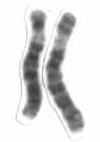Chromosome 6 is one of the 23 pairs of chromosomes in humans. People normally have two copies of this chromosome. Chromosome 6 spans more than 170 million base pairs (the building material of DNA) and represents between 5.5 and 6% of the total DNA in cells. It contains the Major Histocompatibility Complex, which contains over 100 genes related to the immune response, and plays a vital role in organ transplantation.
Identifying genes on each chromosome is an active area of genetic research. Because researchers use different approaches to genome annotation their predictions of the number of genes on each chromosome varies. In January 2017, two estimates differed by 16%, with one estimate giving 3,000 genes, and the other estimate giving 2,516 genes.
In 2003, the entirety of chromosome 6 was manually annotated for proteins, resulting in the identification of 1,557 genes, and 633 pseudogenes.
The human leukocyte antigen lies on chromosome 6 (exception: the gene for β2-microglobulin which is located on chromosome 15), and encodes cell-surface antigen-presenting proteins among other functions. The following are some of the genes and their corresponding Cytogenetic location on chromosome 6:
C6orf10: encoding protein Uncharacterized protein C6orf10
C6orf165: encoding protein DUF3508
RPL10A: encoding protein 60S ribosomal protein L10a
AIM1: encoding protein Absent in melanoma 1 protein (6q21)
AIG1: encoding protein Androgen-induced protein 1 (6q24.2)
BCKDHB: branched-chain keto acid dehydrogenase E1, beta polypeptide (maple syrup urine disease) (6q14.1)
MYO6: myosin VI (6q14.1)
CNR1: cannabinoid 1 receptor (6q14-q15)
HACE1: HECT domain and Ankyrin repeat containing, E3 ubiquitin protein ligase 1 (6q21)
TAAR1: trace amine associated receptor 1 (6q23.1)
TAAR2: trace amine associated receptor 2 (6q24)
EYA4: eyes absent homolog 4 (Drosophila)(6q23.2)
IFNGR: interferon-γ receptor gene (6q23-q24)
OPRM1: μ-opioid receptors (6q24-q25)
IGF2R: insulin-like growth factor 2 receptor (6q25.3)
PLG: plasminogen (6q26)
PARK2: Parkinson disease (autosomal recessive, juvenile) 2, parkin (6q26)
T: T brachyury transcription factor (more commonly known as the T gene) linked to Hepatocellular carcinoma and Chordoma (6q27)
ESR1: Estrogen receptor 1 (6q25)
APOM: encoding protein Apolipoprotein M (6p21.33)
MUT: methylmalonyl Coenzyme A mutase (6p12.3)
VEGF: vascular endothelial growth factor A (angiogenic growth factor) (6p21.1)
PKHD1: polycystic kidney and hepatic disease 1 (autosomal recessive) (6p21.2-p12)
COL11A2: collagen, type XI, alpha 2(6p21.3)
CYP21A2: cytochrome P450, family 21, subfamily A, polypeptide 2 (6p21.33)
HFE: hemochromatosis (6p21.3)
HLA-A, HLA-B, HLA-C: major histocompatibility complex (MHC), class I, A, B, and C loci. (6p21.3)
HLA-DQA1 and HLA-DQB1 form HLA-DQ heterodimer MHC class II, DQ: Celiac1, IDDM (6p21.3)
HLA-DRA, HLA-DRB1, HLA-DRB3, HLA-DRB4, HLA-DRB5 forms HLA-DR, heterodimer MHC class II, DR (6p21.3)
HLA-DPA1 and HLA-DPB1 forms HLA-DR, MHC class II, DP (6p21.3)
HLA-Cw*06:02: gene variation related to psoriasis (6p21.3)
TNXB: tenascin XB (6p21.3)
DSP: Desmoplakin gene linked to cardiomyopathy (6p24.3)
Diseases and disorders
The following diseases are some of those related to genes on chromosome 6:
ankylosing spondylitis, HLA-B
collagenopathy, types II and XI
Coeliac disease HLA-DQA1 & DQB1
Ehlers-Danlos syndrome, classical, hypermobility, and Tenascin-X types
Hashimoto's thyroiditis
hemochromatosis
Hemochromatosis type 1
21-hydroxylase deficiency
maple syrup urine disease
methylmalonic acidemia
Autosomal nonsyndromic deafness
otospondylomegaepiphyseal dysplasia
Parkinson disease
polycystic kidney disease
porphyria
porphyria cutanea tarda
Rheumatoid arthritis, HLA-DR
Stickler syndrome, COL11A2
Systemic lupus erythematosus
Diabetes mellitus type 1, HLA-DR, DQA1 & DQB1
X-linked sideroblastic anemia
Epilepsy
Guillain Barre Syndrome
Chordoma
Hepatocellular carcinoma

